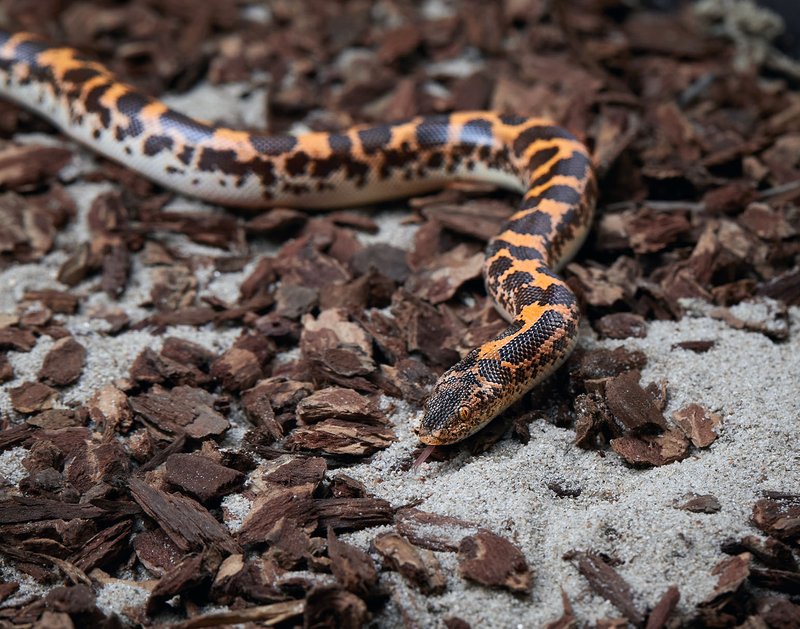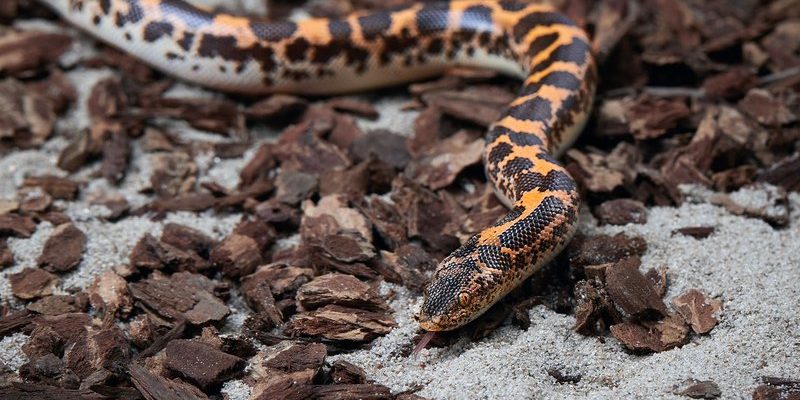
The Kenyan Sand Boa is a captivating species of snake, often found in the arid and sandy regions of East Africa, particularly Kenya. With its distinctive appearance and unique behaviors, this snake has piqued the interest of many snake enthusiasts and casual observers alike. Imagine a creature that looks like it just crawled out of a fairy tale, with its smooth, rounded body and striking coloration. The Kenyan Sand Boa is not just another snake; it’s a remarkable example of adaptation in the wild.
Often mistaken for other more dangerous snakes, the Kenyan Sand Boa actually possesses a gentle demeanor. This makes it a popular choice among reptile lovers. They are relatively small, measuring around 2 to 3 feet, and have a life span that can reach up to 30 years in captivity. With their patience and calmness, they offer a fascinating glimpse into the world of snakes for those willing to look a little closer.
Physical Characteristics
One of the most notable features of the Kenyan Sand Boa is its impressive coloration. Their bodies typically exhibit a combination of browns, yellows, and creams, which serve as excellent camouflage against the sandy and rocky environments they inhabit. This color pattern is not just for aesthetics; it helps them blend in with their surroundings, making it harder for predators and prey to spot them. Their scales are smooth and shiny, giving them a sleek appearance that draws in reptile lovers.
In terms of size, Kenyan Sand Boas are relatively modest compared to some of their larger counterparts. Adult sand boas generally reach lengths between 2 and 3 feet, with females being slightly larger than males. Their short, stocky bodies are designed for burrowing, a behavior they display often. When threatened, they can flatten their bodies and bury themselves in sand or dirt, effectively hiding from danger.
Another interesting aspect of their physicality is their head shape. It is wider than their neck, which allows them to eat prey that is larger than their head by using a technique called “jaw dislocation.” This unique feature is common in many snake species, but it adds an intriguing element to the Kenyan Sand Boa’s hunting strategy.
Habitat and Range
The Kenyan Sand Boa thrives in arid and semi-arid environments. Their preferred habitats include sandy deserts, savannas, and grasslands. This choice of habitat is crucial for their survival, as it provides ample opportunities for burrowing and hunting. You might find them hidden beneath the sand or nestled among the rocks, waiting patiently for their next meal to pass by. Their ability to bury themselves helps them escape the heat of the day while keeping them stealthy in their hunting endeavors.
Geographically, these snakes are native to Kenya and other parts of East Africa. They are often found in regions where the ground is loose and sandy, which makes it easy for them to dig. Their range does not extend into areas with heavy rainfall, as they prefer drier conditions. Interestingly, their habitat preferences also reflect their lifestyle; they are nocturnal creatures, meaning they are most active at night when it’s cooler, allowing them to hunt and mate without the harsh conditions of the day.
As a result, understanding their habitat is essential for those looking to keep Kenyan Sand Boas as pets. Ensuring that their enclosure mimics their natural environment is critical for their wellbeing. A substrate that allows for burrowing, along with proper temperature gradients, can help create a comfortable and enriching habitat for these remarkable snakes.
Diet and Feeding Habits
In the wild, the Kenyan Sand Boa primarily preys on small mammals, such as mice and small rodents. Their feeding method involves ambush tactics, where they remain motionless and hidden until their prey is within striking distance. Once the opportunity arises, they use their quick reflexes to strike, inject venom to immobilize their prey, and then consume it whole. This technique reflects their adaptations and the efficiency of their hunting strategy in the wild.
When housed in captivity, it’s important to replicate their natural diet to keep them healthy. A common practice is to feed them appropriately sized rodents, which can include frozen-thawed mice or rats. It’s crucial to ensure that the prey is no larger than the width of the snake’s body to avoid any risk of choking. Additionally, feeding schedules may vary based on the age and size of the snake; younger snakes may require more frequent meals than adults.
Another noteworthy point is to always monitor the feeding habits of your Kenyan Sand Boa. If they stop eating or display significant changes in behavior, it could be a sign of stress or health issues. Providing a safe and comfortable environment will encourage a healthy appetite, ensuring your snake remains well-fed and happy.
Behavior and Temperament
In terms of behavior, Kenyan Sand Boas are known for their docile nature. They are generally not aggressive and can be quite calm when handled, making them suitable for beginners and experienced reptile keepers alike. Their gentle demeanor is inviting, almost like they’re designed for companionship in a way. Handlers often describe them as “easy-going,” which contributes to their popularity as pets.
You might be wondering about their activity levels. Despite being nocturnal, Kenyan Sand Boas have unique habits. They are not overly active snakes and prefer to spend much of their time hidden away in their substrate. In captivity, this means you might see them more in their burrows rather than basking or roaming. This behavior mirrors their natural instincts in the wild, where staying hidden is vital for both hunting and avoiding predators.
One fascinating aspect of their temperament is their curiosity. While they can appear lethargic, they’re quite inquisitive when it comes to exploring their environment. Providing enrichment, such as hiding spots and climbing structures, can stimulate their natural behaviors. Observing them in a well-decorated enclosure can be quite rewarding, as they exhibit playful behaviors that showcase their personality, allowing you to connect more with them.
Reproduction and Lifespan
The reproductive habits of the Kenyan Sand Boa are another intriguing aspect of their biology. During breeding season, which typically occurs in the warmer months, males will often compete for the attention of females. After a successful courtship, the female will lay eggs, which usually happens about 30 to 40 days after mating. It’s fascinating to think about how life begins for these snakes, hidden away in sandy environments where they are naturally protected from the elements.
In terms of lifespan, Kenyan Sand Boas can live quite long, especially in captivity. With proper care, they can live anywhere from 20 to 30 years, which is impressive when compared to many other reptile species. This longevity makes them a long-term commitment for pet owners, reflecting the importance of being prepared for their care over the years. Their lifespan is influenced by several factors, including diet, habitat conditions, and overall health management.
It’s crucial to provide them with a stable environment and regular veterinary check-ups to ensure their continued health and longevity. Regular assessments help in catching any potential health issues early, allowing owners to provide the best life possible for these fascinating creatures.
Caring for Your Kenyan Sand Boa
If you’re considering adding a Kenyan Sand Boa to your family, understanding their care requirements is essential. First and foremost is their habitat. A securely-enclosed terrarium that mimics their natural habitat is vital. The enclosure should include a substrate that allows for burrowing, such as aspen shavings or sand, along with hiding spots to create a sense of security. Temperature gradients are also important; they need a warm side to bask and a cooler side to retreat to when they want to cool down.
Humidity plays a role as well. Kenyan Sand Boas thrive in a dry environment, so it’s crucial to monitor humidity levels to prevent any health issues. Regular cleaning of their habitat will also help maintain a clean and healthy living space. This is essential for their health and wellbeing, as a dirty environment can lead to health problems such as respiratory infections.
Feeding should be carefully monitored based on their size and age. Young snakes usually require food every 5-7 days, while adults can be fed every 10-14 days. It’s best to feed them during the evening when they are most active, allowing their natural hunting instincts to engage. Lastly, always ensure they have access to fresh water, which should be changed regularly to keep them hydrated.
Conservation Status
When discussing the conservation status of the Kenyan Sand Boa, it’s important to note that they are currently listed as a species of “Least Concern” by the International Union for Conservation of Nature (IUCN). This means that, while they face some threats from habitat destruction and the pet trade, their populations remain relatively stable. However, like many wildlife species, they are still impacted by environmental changes and habitat loss due to human activity.
Conservation efforts are necessary to ensure that their natural habitats are preserved. Local initiatives in Kenya focus on habitat restoration and educating communities on the importance of biodiversity and wildlife conservation. By fostering a deeper understanding of these creatures and their roles within ecosystems, we can help protect them for future generations.
If you’re a reptile enthusiast, being mindful of where you acquire your Kenyan Sand Boa is essential. Supporting reputable breeders and organizations that prioritize animal welfare can help combat the harmful effects of illegal wildlife trade. This way, you’re not just bringing home a pet but also contributing to the overall conservation of the species.
FAQ
What is the average size of a Kenyan Sand Boa?
Typically, Kenyan Sand Boas measure between 2 to 3 feet in length. Females are generally larger than males. Their size is well-suited for their burrowing lifestyle.
Can Kenyan Sand Boas be kept with other reptiles?
While it’s possible to house different species together, it’s generally not recommended. Each species has its own territorial needs and stress levels. It’s safer to keep Kenyan Sand Boas alone to avoid conflicts.
Do Kenyan Sand Boas require UV lighting?
Unlike some reptile species, Kenyan Sand Boas do not require UV lighting. However, providing a proper temperature gradient in their habitat is crucial for their health and digestion.
How often should I feed my Kenyan Sand Boa?
Feeding frequency depends on the age and size of your boa. Younger snakes need to be fed every 5-7 days, while adults can be fed every 10-14 days. Always ensure the prey is appropriately sized.
Are Kenyan Sand Boas venomous?
No, Kenyan Sand Boas are not venomous. They rely on constriction to subdue their prey, making them safe for handling. Their gentle nature also makes them a popular choice among pet owners.
What is the best substrate for a Kenyan Sand Boa’s habitat?
A good substrate is crucial for a Kenyan Sand Boa. Aspen shavings or sand can provide the necessary environment for burrowing, which they enjoy. Avoid cedar or pine shavings, as they can be harmful.
How can I tell if my Kenyan Sand Boa is healthy?
Signs of a healthy Kenyan Sand Boa include alertness, regular feeding, and clear eyes. Regular vet check-ups can help ensure they remain healthy. Watch for any changes in behavior or appetite as potential health indicators.

